Packington Old Hall is a 17th-century manor house situated at Great Packington, near Meriden, Warwickshire. It is a Grade II listed building. It stands in gardens enclosed by late 17th century brick walls.
Contents

Packington Old Hall is a 17th-century manor house situated at Great Packington, near Meriden, Warwickshire. It is a Grade II listed building. It stands in gardens enclosed by late 17th century brick walls.

The original Packington Manor House (now known as Packington Old Hall) was rebuilt in red brick in 1679 for Sir Clement Fisher, 2nd Baronet, [1] and his wife Jane Lane. In 1690, it was described as ‘a sweet seat, near the road, with a park on the other side, with a fair lodge and an avenue of fir-trees to the hall’. [2]
There is an oblong shaped brick dovecote about 50m away from the Old Hall which was used for housing doves and pigeons. It has over 100 nesting places on three of the walls. [3]
In 1693 Sir Clement Fisher's nephew, also Sir Clement Fisher, 3rd Baronet, built another larger mansion on the estate. The new house became known as Packington Hall and from 1729 the house has been the seat of the Earls of Aylesford.

Earl of Aylesford, in the County of Kent, is a title in the Peerage of Great Britain. The junior branch of the Earl of Winchilsea and Nottingham. It was created in 1714 for the lawyer and politician Heneage Finch, 1st Baron Guernsey. He had already been created Baron Guernsey in the Peerage of England in 1703.
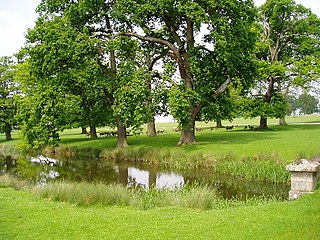
Great Packington, historically known as Packington Magna, is a hamlet, civil parish and country park in the North Warwickshire district of Warwickshire, England. The parish of Meriden is to the south-east, and Little Packington to the west. At Great Packington is Packington estate, which includes Packington Hall, Packington Old Hall and the Greek revival style St James' Church.

Nether Whitacre is a small village and larger rural civil parish in North Warwickshire, Warwickshire, England.

Kinwarton is a village in the valley of the River Alne, Warwickshire, to the north-east of the market town of Alcester. The population of the civil parish at the 2011 Census was 1,082. The ground is mostly low-lying, with a maximum altitude of 206 ft. and some of the fields near the river are liable to floods. The road from Alcester to Henley-in-Arden runs through the middle of the parish. A branch road leads off to the church and rectory about a quarter of a mile to the south and thence continues as a field-path down to a ford across the River Alne below Hoo Mill. From the north side of the main road a by-road branches off to Coughton.

Offchurch Bury is a manor house one mile north-west of the centre of the village of Offchurch, Warwickshire, England. It is supposed to represent the site of a palace of the Anglo-Saxon King Offa of Mercia (d.796), after which Offchurch is named, "bury" being a corruption of "burh" meaning a fortified place. William Dugdale in his Antiquities of Warwickshire (1656) stated concerning the manor of Offchurch:
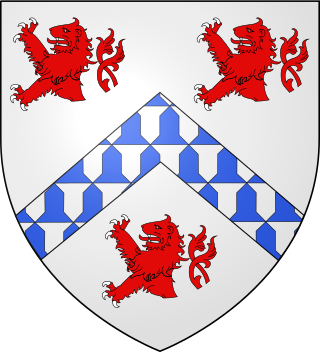
There have been two baronetcies created for persons with the surname Fisher, both in the Baronetage of England.

Burton Agnes Hall is an Elizabethan manor house in the village of Burton Agnes, near Driffield in the East Riding of Yorkshire, England. It was built by Sir Henry Griffith in 1601–10 to designs attributed to Robert Smythson. The older Norman Burton Agnes Manor House, originally built in 1173, still stands on an adjacent site; both buildings are now Grade I listed buildings.
Packington is a village and civil parish in Leicestershire, England.

Packington Hall is a 17th-century mansion situated at Great Packington, near Meriden in Warwickshire, England and is the seat of the Earl of Aylesford. It is a Grade II listed building.
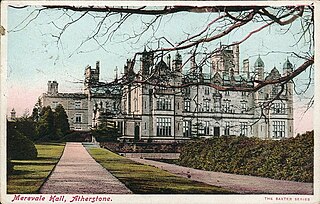
Merevale Hall is a private country house in Merevale, near Atherstone, Warwickshire, England. It is a Grade II* listed building. The estate descends from Merevale Abbey which once stood on the site.
Hermitage Manor is a small manor house in Warwickshire (UK) with a trihedral moat, associated land and farm. A manor house or fortified manor-house is a country house, which has historically formed the centre of a manor. The term is sometimes applied to relatively small country houses which belonged to gentry families, as well as to grand stately homes, particularly as a technical term for minor late medieval castles more intended for show than for defence.

Lytes Cary is a manor house with associated chapel and gardens near Charlton Mackrell and Somerton in Somerset, England. The property, owned by the National Trust, has parts dating to the 14th century, with other sections dating to the 15th, 16th, 18th, and 20th centuries. "Yet all parts blend to perfection with one another and with the gentle sunny landscape that surrounds them," comments Nikolaus Pevsner. The House is listed as Grade I by English Heritage.
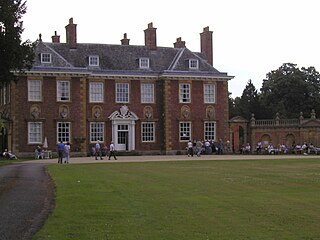
Honington Hall is a privately owned 17th century country house at Honington, near Stratford on Avon, Warwickshire. It has Grade I listed building status.
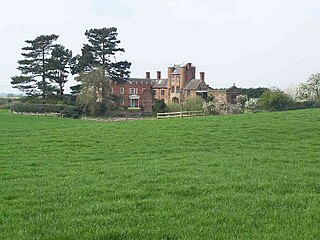
Sir Edward Littleton, 1st Baronet was a 17th-century English Baronet and politician from the extended Littleton/Lyttelton family, the first of a line of four Littleton baronets with Pillaton Hall as their seat. He initially joined the Parliamentarians during the English Civil War. Having tried unsuccessfully to find a third way, he switched his support to the Royalist cause – a decision that led to his financial ruin, as large debts made it impossible to redeem his estates from sequestration after the victory of Parliament.
William Courtenay, 1st Viscount Courtenay, also de jure 7th Earl of Devon, was a British peer. He was the son of William Courtenay, 6th Earl of Devon and 2nd Baronet Courtenay, and Lady Anne Bertie.

Westwell is a small village and civil parish about 2 miles (3 km) southwest of the market town of Burford in Oxfordshire. It is the westernmost village in the county, close to the border with Gloucestershire.

Hangleton Manor Inn, the adjoining Old Manor House and associated buildings form a bar and restaurant complex in Hangleton, an ancient village which is part of the English city of Brighton and Hove. The manor house is the oldest secular building in the Hove part of the city; some 15th-century features remain, and there has been little change since the High Sheriff of Sussex rebuilt it in the mid-16th century. Local folklore asserts that a 17th-century dovecote in the grounds has been haunted since a monk placed a curse on it. The buildings that comprise the inn were acquired by Hangleton Manor Ltd in 1968, and converted to an inn under the Whitbread banner. The brewery company Hall & Woodhouse have owned and operated it since 2005. English Heritage has listed the complex at Grade II* for its architectural and historical importance, and the dovecote is listed separately at Grade II.

Pillaton Hall was an historic house located in Pillaton, Staffordshire, near Penkridge, England. For more than two centuries it was the seat of the Littleton family, a family of local landowners and politicians. The 15th century gatehouse is the main surviving structure of medieval Pillaton Hall. It is a Scheduled Ancient Monument and a Grade II* listed building. Attached to the Gatehouse to the east is the chapel formerly dedicated to Saint Modwen.
Sir Clement Fisher, 2nd Baronet was an English politician who sat in the House of Commons from 1661 to 1679. He supported the Royalist cause in the English Civil War.

Moulsecoomb Place is a large 18th-century house on Lewes Road in the Moulsecoomb area of the English coastal city of Brighton and Hove. Originally a farmhouse based in an agricultural area in the parish of Patcham, north of Brighton, it was bought and extensively remodelled in 1790 for a long-established local family. It was their seat for over 100 years, but the Neoclassical-style mansion and its grounds were bought by the local council in the interwar period when Moulsecoomb was transformed into a major council estate. Subsequent uses have varied, and Moulsecoomb Place later became part of the University of Brighton's range of buildings. Student housing has been built to the rear; but much of the grounds, the house itself and a much older cottage and barn attached to the rear have been preserved. The house is a Grade II Listed building.